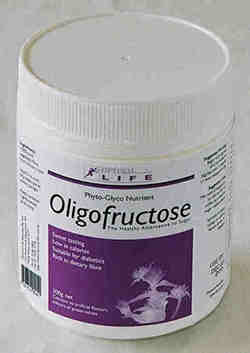|
Oligofructose 300g Recommended Retail Price N/A
We no longer see Oligofructose. Thank you.
Optimal Life offers a product that who would have thought could do all the following?
"Sweet and Healthy" Inulin is a term applied to fructose polymers commonly found in nature as plant storage carbohydrates. Significant amounts of Inulin are found in artichokes, asparagus, salsify, leeks, onions and garlic but it is found in its greatest concentration in chicory (a relative of the dandelion). Oligofructose is a subgroup of Inulin with shorter chain fructose polymers. Phyto-Glyco Nutrient Oligofructose is extracted from chicory by simply using hot water. Its benefits are many: Sweet: Pure Oligofructose is slightly sweet, without any aftertaste or off-flavour. Its sweetness profile is comparable to that of sucrose. Imagine being able to take a healthy fibre as a sweetener? Reduced calorie intake: Since Oligofructose is not digested in the upper intestinal tract, the only way it can increase caloric intake is through fermentation in the colon. This pathway is far less efficient than when carbohydrates are absorbed in the small intestine and directly metabolised in the liver. The consensus is that Oligofructose has a caloric value of 1.5 kcal/g Diabetic friendly: Sugars and carbohydrates are absorbed as monosaccharides (single sugar molecules) in the small intestine. Oligofructose passes through the small intestine largely untouched, as do all dietary fibres. This explains why Oligofructose does not increase the insulin level in the blood and hence why it is ideally suited for diabetics. Rich in fibre: Oligofructose is a soluble dietary fibre showing significant dietary fibre effects. Given that we barely consume two-thirds of the recommended daily intake in fibres, using Oligofructose as a source of dietary fibre can result in a more balanced diet. According to research papers presented in the Journal of the American Medical Association (JAMA) on obesity it was found that fibre intake was more important than fat. "Fibre consumption predicted insulin levels, weight gain, and other Cardiovascular Disease risk factors more strongly than did total or saturated fat consumption. High-fibre diets may protect against obesity and Cardiovascular Disease by lowering insulin levels_." _David S. Ludwig, MD, PhD; Mark A. Pereira, PhD et al. Dietary Fibre, Weight Gain, and Cardiovascular Disease Risk Factors in Young Adults. JAMA; 1999; 282:1539-1546
Prebiotic effect: Strong evidence exists for a prebiotic effect and improved bowel habit. Prebiotic is a non-digestible food ingredient which has a beneficial effect on the host by selectively stimulating the growth and/or activating the metabolism of one or a limited number of health promoting bacteria in the intestinal tract, thus improving the host’s intestinal balance. Daniel Gallaher of the University of Minnesota and Ian Rowland of the University of Ulster, UK described how the combination of prebiotics (inulin/oligofructose) and probiotics (bifidobacteria) was most effective in reducing colon cancer risk. Henryk Taper of the Catholic University of Louvain, Belgium, discussed his work in animal models with carcinogen-induced mammary tumors as well as transplanted liver and breast tumors in animals fed oligofructose or inulin as 15 percent of the diet. Results have shown a significant decrease in cancer incidence, the number of tumors and the growth of tumors. Improved calcium uptake: Studies have shown that Oligofructose increases the absorption of Calcium in the body by up to 30% and even improves bone mineral density. This could have important consequences for the prevention of osteoarthritis. Bifidus stimulation: Oligofructose is recognised as an efficient bifidus stimulator in our diet. Extensive research has demonstrated that ingesting moderate amounts of Oligofructose results in a significant increase (5 — 10 times more) of the beneficial bifidobacteria in the intestinal tract. Simultaneously it reduces the levels of undesirable bacteria such as E. coli. The "friendly" bacteria are responsible for antibiotic, antiviral and anticancer effects. Triglyceride reduction: Christine Williams of the University of Reading, UK, reported that a diet supplemented with 10g/day of inulin for eight weeks can significantly decrease blood triglyceride levels. Recommended dosage: Beginning with 5g/day, gradually increase dosage to 15 — 20g per day over a few weeks. (One level teaspoon is equivalent to 2.5g) Because of the high fibre content of Oligofructose, immediately taking 20g/day can lead to flatulence and diarrhoea. Suggested use: Mix with orange juice, or add to tea or coffee as a healthy sugar replacement. Put on your cereal or add to a lemon drink or desert. Keep container tightly sealed after each use as the powder does absorb moisture and can develop a sticky crust if exposed to the atmosphere for extended periods. Disclaimer: All information should be considered educational only. Consult your physician for all health advice and treatment.
|
||
73 Shore St East, (C)
1998-2001
Optimal Life Australia Pty. Ltd.
|
||


